The AMD A8-7650K APU Review, Also New Testing Methodology
by Ian Cutress on May 12, 2015 10:00 AM ESTOffice Performance
The dynamics of CPU Turbo modes, both Intel and AMD, can cause concern during environments with a variable threaded workload. There is also an added issue of the motherboard remaining consistent, depending on how the motherboard manufacturer wants to add in their own boosting technologies over the ones that Intel would prefer they used. In order to remain consistent, we implement an OS-level unique high performance mode on all the CPUs we test which should override any motherboard manufacturer performance mode.
All of our benchmark results can also be found in our benchmark engine, Bench.
Dolphin Benchmark: link
Many emulators are often bound by single thread CPU performance, and general reports tended to suggest that Haswell provided a significant boost to emulator performance. This benchmark runs a Wii program that raytraces a complex 3D scene inside the Dolphin Wii emulator. Performance on this benchmark is a good proxy of the speed of Dolphin CPU emulation, which is an intensive single core task using most aspects of a CPU. Results are given in minutes, where the Wii itself scores 17.53 minutes.
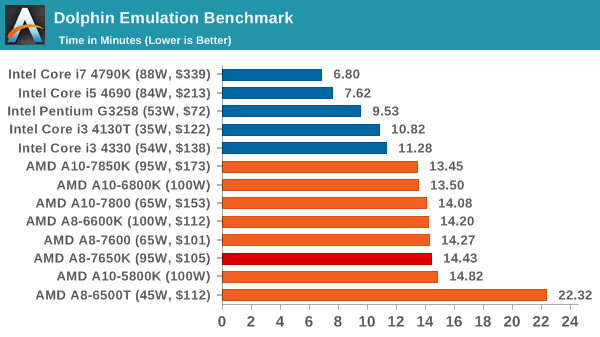
Dolphin likes high IPC and clock frequency, which indicates that the highest clocked APUs perform the best out of AMD here. Because the benchmark is single threaded, even a dual core Intel wins though.
WinRAR 5.0.1: link
Our WinRAR test from 2013 is updated to the latest version of WinRAR at the start of 2014. We compress a set of 2867 files across 320 folders totaling 1.52 GB in size – 95% of these files are small typical website files, and the rest (90% of the size) are small 30 second 720p videos.

The varied-thread workload of WinRAR seems to vary between the dual core Intels and the dual module AMD chips, showing that threads matter.
3D Particle Movement
3DPM is a self-penned benchmark, taking basic 3D movement algorithms used in Brownian Motion simulations and testing them for speed. High floating point performance, MHz and IPC wins in the single thread version, whereas the multithread version has to handle the threads and loves more cores.

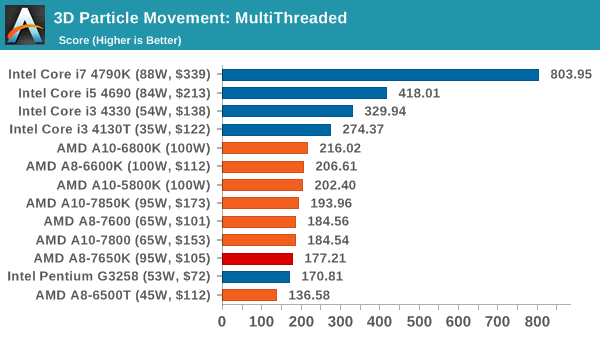
In this nieve benchmark, the compiler prefers x87 style commands which AMD's Bulldozer based architectures isn't too fond of. This benchmark is meant to be a representation of crude scientific code, similar to that used in a research lab. Ultimately, Bulldozer architectures such as Kaveri prefer specific commands, especially when dealing with basic math.
FastStone Image Viewer 4.9
FastStone is the program I use to perform quick or bulk actions on images, such as resizing, adjusting for color and cropping. In our test we take a series of 170 images in various sizes and formats and convert them all into 640x480 .gif files, maintaining the aspect ratio. FastStone does not use multithreading for this test, and results are given in seconds.
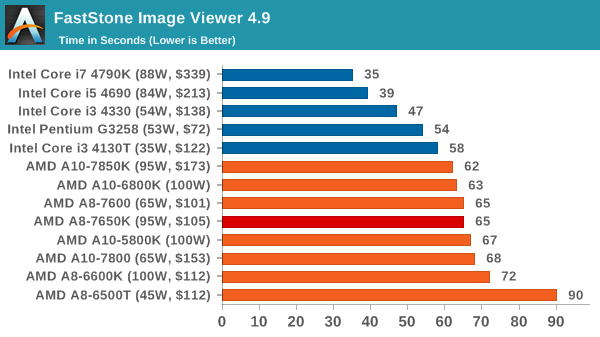
Web Benchmarks
On the lower end processors, general usability is a big factor of experience, especially as we move into the HTML5 era of web browsing. For our web benchmarks, we take four well known tests with Chrome 35 as a consistent browser.
Sunspider 1.0.2

Mozilla Kraken 1.1

WebXPRT
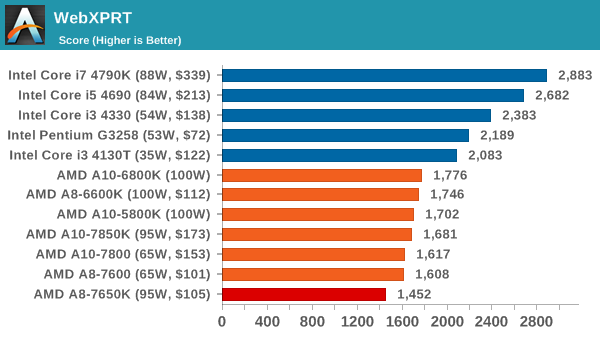
Google Octane v2
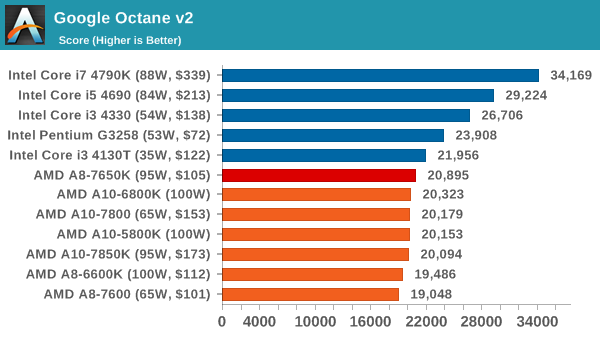










177 Comments
View All Comments
Sejong - Tuesday, May 12, 2015 - link
No comments. That just states AMD`s current position.bumble12 - Tuesday, May 12, 2015 - link
Well, if you post a minute or two after the review goes live, what might you expect exactly?YuLeven - Tuesday, May 12, 2015 - link
I think you'll find that he said "no comments" as in "no comments about AMD's poor performance", not as in "there aren't comments on this review" pal.anandreader106 - Tuesday, May 12, 2015 - link
....not sure if serious....or trolling....DevilSlayerWizard - Tuesday, May 12, 2015 - link
I would prefer if AMD made a quad core Zen with ''atleast'' 1024 GCN cores, whatever memory subsystem needed to feed the chip including RAM and motherboard for less than 500$ in 2016. Pretty reasonable if you ask me.barleyguy - Tuesday, May 12, 2015 - link
The PS4 processor, which AMD makes, is an R9-280 with an 8 core CPU. The problem is that it would be memory limited quite badly on a PC motherboard. In the PS4 it's paired with very fast memory.Possibly when AMD goes to DDR4 their APUs will start to shine, and they'll have the memory bandwidth to go wider on the GPU.
extide - Tuesday, May 12, 2015 - link
No, it's not. It is roughly between an R7 265 and R9 270 -- not anywhere near an R9 280.ravyne - Tuesday, May 12, 2015 - link
Its not a 280 -- Its got 20 GPU clusters only for 1280 shader lanes, two clusters are there for yield purposes and 4 more are dedicated to compute tasks. It has only 896 shaders dedicated to graphics, and and 256 for compute (though some engines leverage compute during rendering, so the line is a bit fuzzy). The PS4 has a 512bit memory bus, which is really wide for the GPU power, but its also feeding CPU compute. Its got 8 ACES like the 290/X.The 280 fully unlocked has 32 clusters for 2048 shaders. A 280/X has a 256bit GDDR5 bus, and only 2 ACES.
What's in the PS4 is also custom-extended beyond any retail GPU, but the closest thing would be like a Hawaii (290/X) or Tonga (285), but cut down to 18 clusters.
Revdarian - Wednesday, May 13, 2015 - link
The ps4 doesn't have 256 shaders for compute only, it has 1280 shaders total and that is it, how you decide to divide the workload for your engine is up to you, what you are thinking of was totally taken out of the context of it being an example of how to use the tools provided to the developers.nikaldro - Saturday, May 16, 2015 - link
Ps4 has 1152